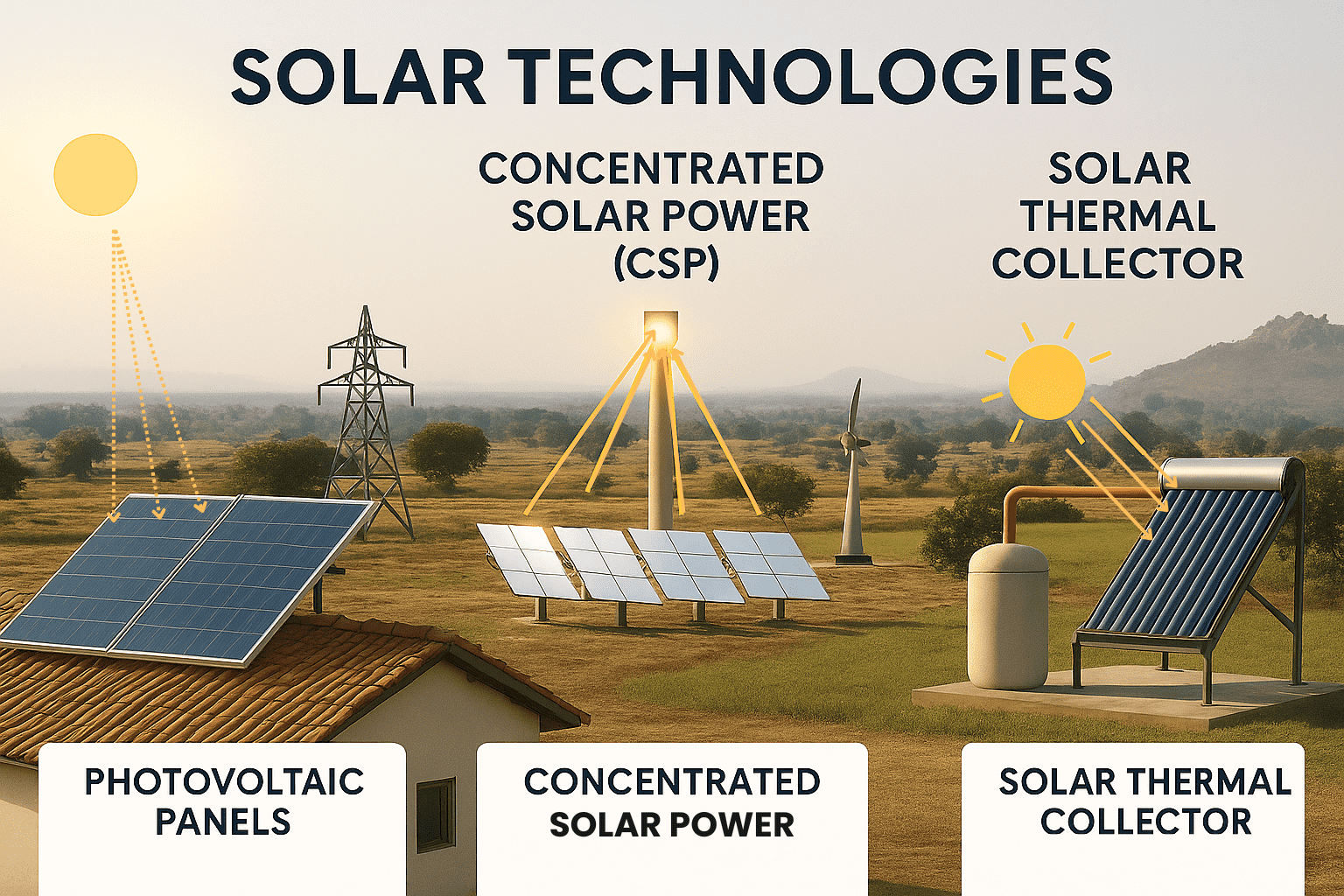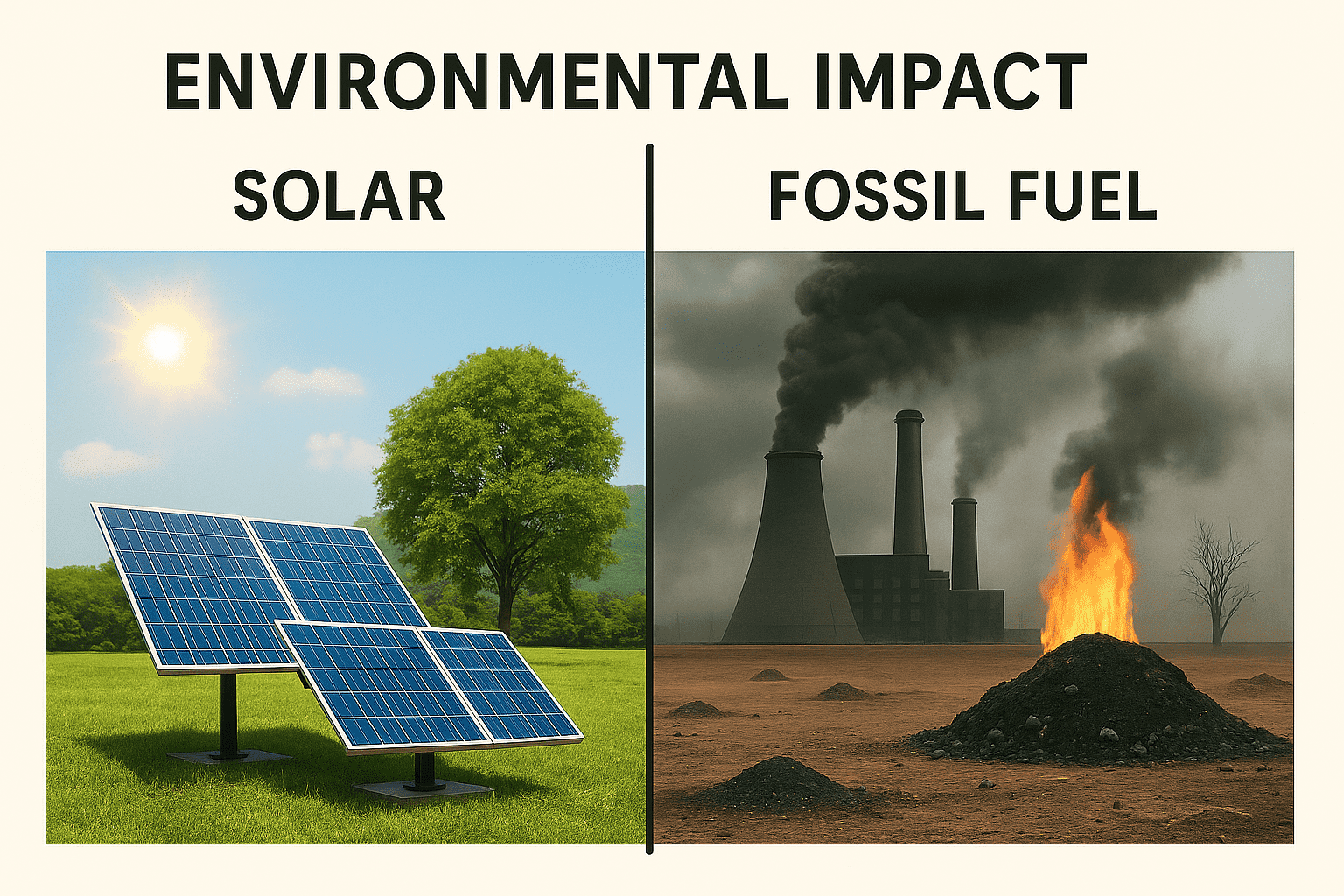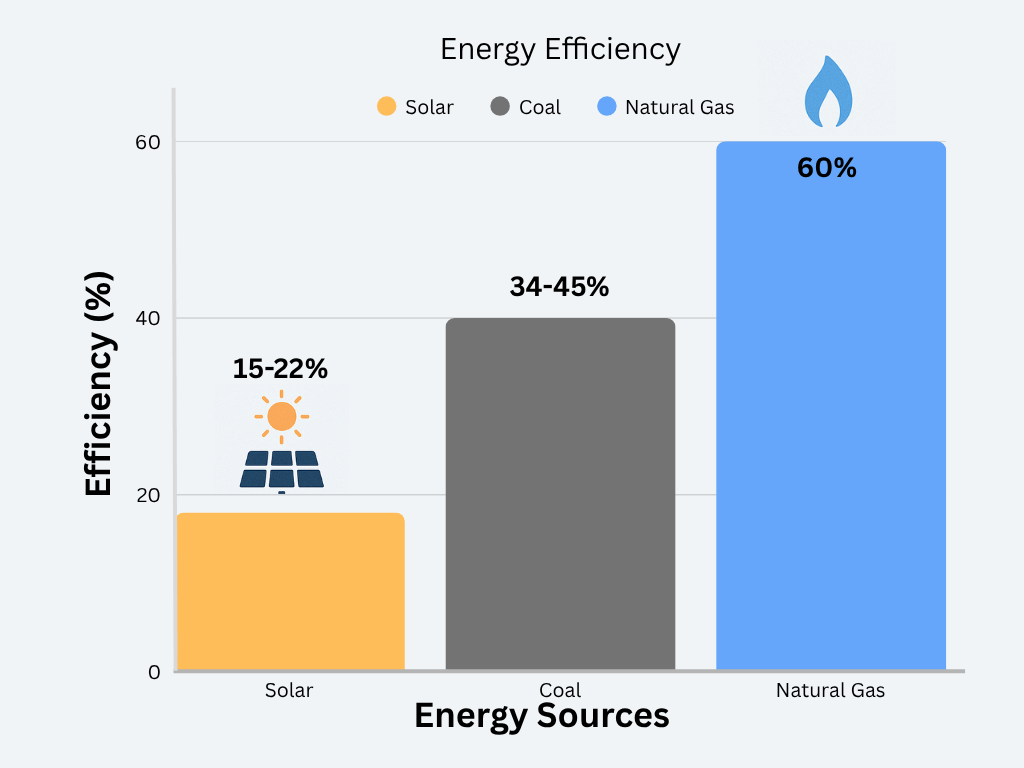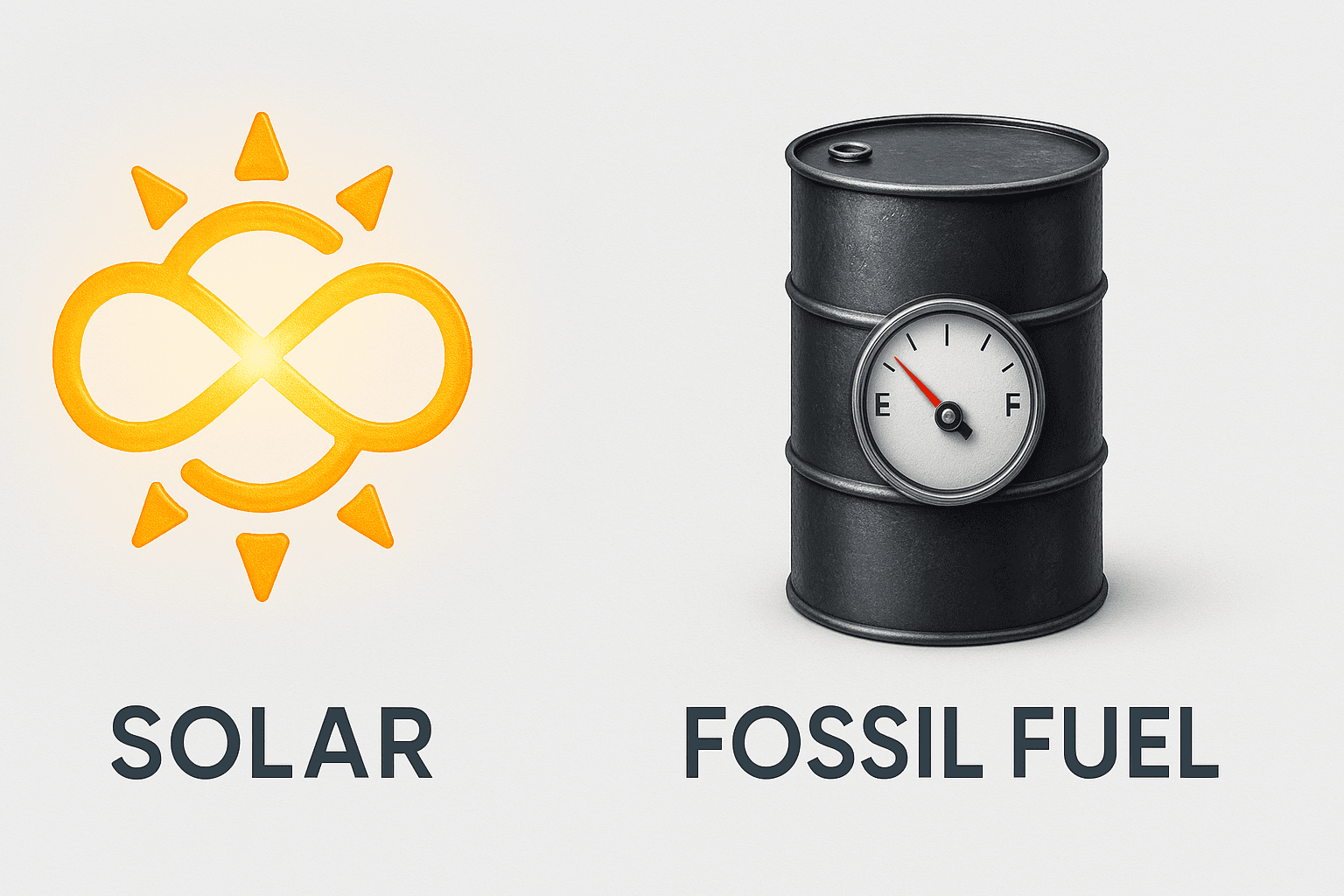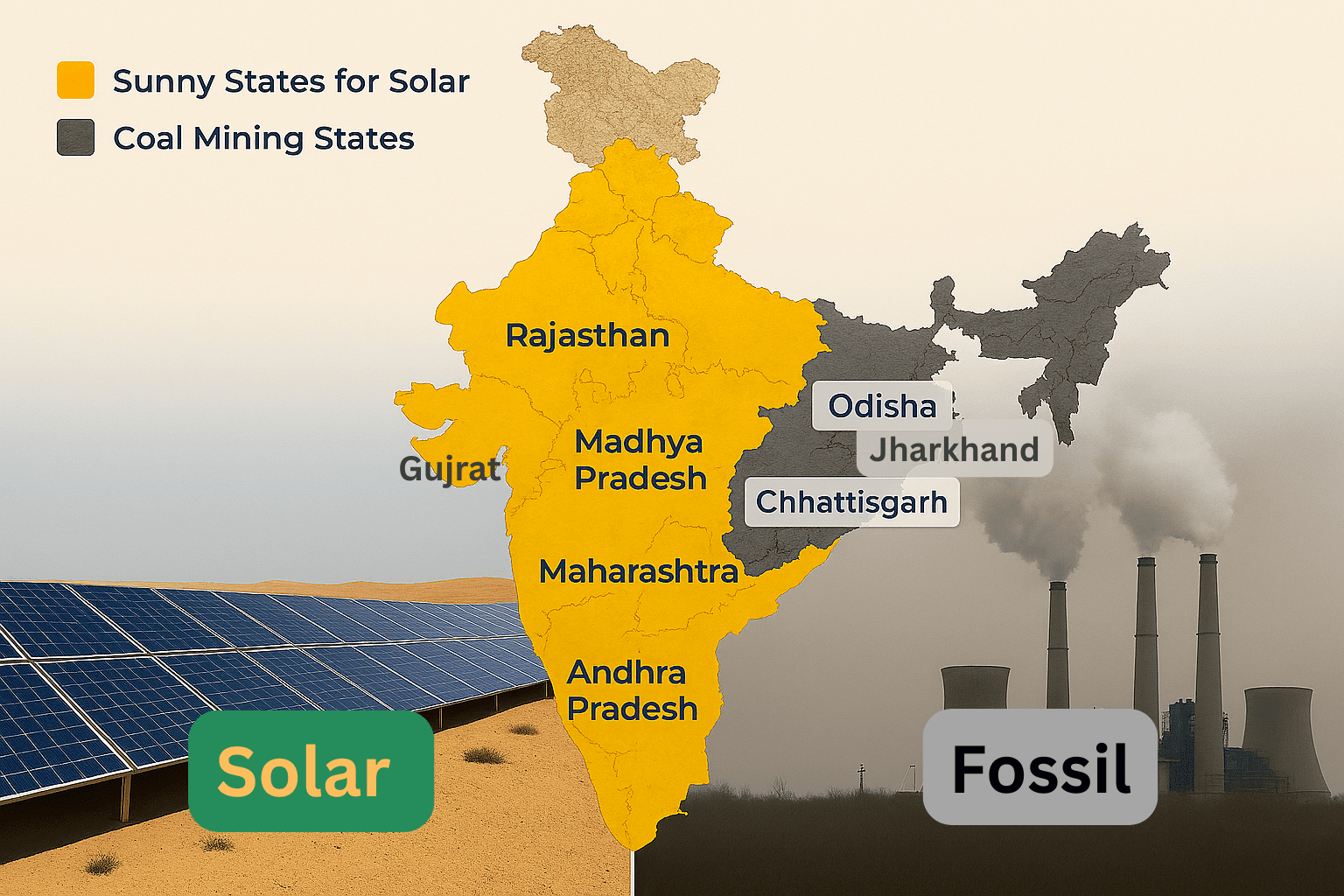Is your electricity powering the future or draining it? As India races toward energy independence, the choice between solar power and fossil fuels has never been more urgent.
One is clean, renewable, and rising fast. The other is familiar but linked to pollution and rising health concerns (explored below).
This guide gives you the full picture:
- The real costs of both solar and fossil fuels
- Efficiency levels, environmental impact, and long-term potential
- Clear pros, cons, and what’s better for India’s sustainable future
Whether you’re concerned about the environment and disadvantages of fossil fuels or curious about how solar energy compares in cost and impact? You’re in the right place.
Let’s unpack the solar energy vs fossil fuels debate clearly, fairly, and backed by real-world data, so you can make smarter choices for the planet and your pocket.
What is Solar Energy?
Solar energy is the power we get from sunlight. It’s clean, renewable, and can be converted into electricity or heat using different technologies.
According to the International Energy Agency (IEA), India is set to become the third-largest solar market globally, thanks to falling prices and strong policy support.
How Does Solar Energy Work?
There are three main ways solar energy is used:
A. Photovoltaic (PV) Systems
- Use solar panels made of PV cells
- Convert sunlight directly into electricity
- Commonly used for homes, businesses, and solar farms
B. Concentrated Solar Power (CSP)
- Uses mirrors or lenses to focus sunlight
- Generates heat, which powers turbines to create electricity
- Usually used in large utility-scale projects
C. Solar Thermal Collectors
- Capture sunlight to heat water or air directly
- Often used for solar water heaters or space heating
In India, PV systems are the most popular due to cost-effectiveness and government subsidies, especially in residential and agricultural areas.
Why is Solar Energy Gaining Popularity?
- Sunlight is free and unlimited
- Reduces electricity bills long-term
- Works well across most of India
- Supports clean energy goals
- Reduces dependency on fossil fuel imports
Key Benefits of Solar Energy
- Clean and low-maintenance
- No air or water pollution during operation
- Scalable from small rooftops to large farms
- Reduces the disadvantages of fossil fuels, like pollution and resource depletion
- Improves energy access in off-grid regions
👉 Read, What Are The Advantages and Disadvantages Of Solar Power
What are Fossil Fuels?
Fossil fuels are energy sources formed over millions of years from the remains of ancient plants and animals buried under layers of earth. Heat and pressure transformed this organic matter into coal, oil, and natural gas.
These fuels are extracted through mining or drilling, processed in refineries or plants, and then used to generate electricity, powers to vehicles, and fuel industries.
Their non-renewable nature means fossil fuels will eventually run out, so consequences discussed later in environmental and health sections.
Fossil fuels include:
- Coal : Burned in power plants to produce electricity
- Crude Oil (Petroleum) : Refined into petrol, diesel, jet fuel
- Natural Gas : Used for heating, electricity, and as cooking fuel
- Liquefied Petroleum Gas (LPG) : Common in Indian households
According to the IEA India Energy Outlook relies heavily on fossil fuels, importing over 85% of its crude oil needs and generating more than 55% of its electricity from coal.
Established Fossil Fuel Infrastructure
Fossil fuels like coal, oil, and gas have been used for many years. Because of this, we already have a strong system to move and use them.
- Pipelines carry oil and gas underground to power plants and factories.
- Railways and trucks transport coal across the country.
- Ships and tankers carry fuel between countries.
This system is already built, so it’s cheaper to use. There’s no need to build something new.
That’s why fossil fuels are still used a lot. It’s easier to scale them up (make more) using the systems we already have. But keeping this old system running costs money and still harms the environment.
A Global Energy Backbone
Despite their drawbacks, fossil fuels remain the primary source of global energy, due to:
- High energy density (a lot of energy in a small amount)
- Well-established infrastructure (pipelines, refineries, transport)
- Stable and large-scale electricity generation
That’s why, even in 2025, fossil fuels dominate the global energy landscape, although the disadvantages of fossil fuels are pushing many countries including India to adopt cleaner alternatives like solar.
Comparative Analysis of Solar Energy and Fossil Fuel
When comparing solar energy vs fossil fuels, it’s important to understand that we’re evaluating a renewable technology versus a limited fuel source.
To fairly assess the pros and cons of fossil fuels and solar energy, we’ll examine them across these key areas:
- Cost
- Environmental impact
- Efficiency
- Resource availability
- Health impact
- Scalability and infrastructure
- Storage and distribution
- Technological development
- Economic and job impact
- Geographical considerations
1. Is Solar Energy Cheaper Than Fossil Fuels in India?
The cost of electricity from new coal-fired plants in India ranges from ₹4.50–₹6.00 per kWh, excluding environmental and health externalities.
While solar energy costs in India have dropped by over 85% since 2010, reaching ₹2.50–₹3.50 per kWh, making it one of the cheapest sources of electricity in the country. (Source: MNRE Reports)
Fossil Fuels
Initial Investment
- High capital required for extraction, refining, and infrastructure (e.g. oil rigs, refineries, pipelines).
- Costs are distributed over large-scale production, making per-unit energy relatively cheap.
Operational & Maintenance Costs
- Includes labor, transportation, equipment upkeep, and safety compliance.
- India’s dependency on fuel imports adds significant transport and geopolitical cost layers.
Subsidies and Tax Benefits
- Governments often offer heavy subsidies and tax incentives to fossil fuel producers to keep prices stable.
- According to the IMF (International Monetary Fund), global fossil fuel subsidies reached $7 trillion in 2022, with India being a top contributor.
Solar Energy
Initial Investment
- High upfront cost due to solar panels, batteries (if used), inverters, and professional installation.
- This cost is front-loaded but reduces over time with virtually no fuel cost.
Operational & Maintenance Costs
- Very low ongoing costs limited to basic cleaning and occasional servicing.
- Most systems come with 20–25 years of warranty, making it low-risk in the long term.
Incentives and Rebates : Indian government offers multiple supports, such as:
- Subsidies under PM Surya Ghar Yojana for residential rooftop systems
- Tax benefits under Section 80-IA of the Income Tax Act
- Net metering, allowing users to sell unused electricity back to the grid
The shift in price comparison of solar and fossil energy clearly favours solar when considering incentives, low running costs, and long-term savings, especially in sun-rich countries like India.
2. How Solar & Fossil Fuels Affect the Environment
The environmental effects of solar energy vs fossil fuels are among the most important differences between the two. While fossil fuels are known for pollution and ecological harm, solar offers a cleaner but not entirely impact-free alternative.
Fossil Fuels: High Environmental Burden
Greenhouse Gas Emissions
- Burning coal, oil, and gas releases large amounts of carbon dioxide (CO₂), a major driver of climate change.
- Fossil fuels account for nearly 75% of global greenhouse gas emissions (source: UN Climate Reports).
Air Pollution
- Releases particulate matter, nitrogen oxides, and sulfur dioxide, which contribute to smog, acid rain, and respiratory illnesses.
- India faces some of the world’s worst urban air quality due to heavy reliance on coal power.
Water & Soil Pollution
- Oil spills, coal ash leaks, and gas drilling can contaminate rivers, groundwater, and farmland.
- These pollutants affect ecosystems and pose risks to both wildlife and human health.
Ecological Disruption
- Mining, drilling, and pipeline construction damage forests, coastlines, and marine life habitats.
- Some sensitive zones like the Arctic and deep seas face irreversible damage due to fossil fuel exploration.
Solar Energy: Low Operational Impact, Some Manufacturing Concerns
Low Emissions During Use
- Solar energy systems produce no direct emissions while generating electricity.
- This makes them a clean and climate-friendly option, especially when replacing coal or diesel.
Water Use
- Solar PV systems require very little water, unlike fossil fuel plants that need massive amounts for cooling.
- This is especially beneficial in water-stressed regions of India.
Land Use & Ecosystem Effects
- Large solar farms require open land, which can affect local ecosystems and biodiversity.
- Solutions include using barren, non-agricultural land, dual-use solar farming (agrivoltaics), or installing panels on rooftops and canals to reduce land pressure.
Manufacturing & Disposal Challenges
- Solar panels are made using materials like cadmium, lead, and silicon, some of which are hazardous.
- Manufacturing processes may still rely on fossil fuels, and photovoltaic cells disposal remains a challenge due to limited recycling infrastructure.
- India is beginning to develop solar waste rules, but large-scale recycling systems are still in progress (source: MNRE Draft Solar Waste Guidelines).
3. Solar vs Fossil Fuel: Which Is More Efficient?
Energy efficiency measures how well a source converts input into usable power. In the debate of solar energy vs fossil fuels, efficiency is a key factor, but must be understood across both short-term performance and long-term output.
Fossil Fuels: High Energy Density, But Not Without Loss
- High energy density: Fossil fuels like coal, oil, and natural gas contain a large amount of energy per unit, making them ideal for high-demand, industrial-scale energy needs.
- Conversion efficiency: Fossil fuel-based power plants generally operate at 35%–45% efficiency, meaning over half of the energy is lost as heat during combustion.
- Energy loss: Burning fuels generates waste heat, contributing to inefficiency and environmental stress.
- Flexibility & Reliability: Fossil fuels offer round-the-clock energy, independent of weather conditions—making them a historically reliable energy backbone, especially in large grids like India’s.
Solar Energy: Steady Improvements with Long-Term Gains
- Lower initial efficiency: Most commercial solar panels convert sunlight at 15%–22% efficiency, while modern coal-fired power plants operate at 35%–45% thermal efficiency, and combined-cycle natural gas plants can reach up to 60% under optimal conditions.
(Source: U.S. Energy Information Administration – EIA)
- Minimal energy loss: Unlike combustion, solar systems don’t lose energy to heat. Over decades, they maintain performance with only minor degradation (~0.5% per year).
- Location & weather dependent: Solar output varies based on sunlight availability, regions like Rajasthan, Gujarat, and Telangana benefit from high solar potential in India.
- Rapid technological advancement: New innovations like bifacial panels, PERC cells, and solar tracking systems are steadily improving both efficiency and consistency.
- With battery storage and smart grids, solar energy is becoming more reliable, even during cloudy days or nighttime.
4. Are Solar and Fossil Fuel Resources Sustainable for India?
The availability of energy resources is a critical factor in long-term sustainability. India’s coal reserves are expected to last for about 40–60 more years at current consumption rates, whereas solar energy is virtually inexhaustible and available for over 270 days annually in most Indian states.
When comparing solar energy vs fossil fuels, the difference between finite and renewable becomes a major turning point.
Fossil Fuels: Finite and Unevenly Distributed
- Limited reserves: Fossil fuels like coal, oil, and natural gas are non-renewable, formed over millions of years and depleted with every use.
- Uneven global distribution: Oil and gas reserves are concentrated in specific regions like the Middle East, Russia, and the U.S., creating dependency and trade imbalances.
- Geopolitical risks: This uneven distribution has led to energy-related conflicts, price volatility, and supply disruptions, especially for countries like India, which imports a large share of its fossil fuels.
- Depletion concerns: As reserves shrink and extraction becomes more difficult, long-term availability and affordability of fossil fuels will decline.
Solar Energy: Inexhaustible and Widely Accessible
- Renewable by nature: Solar energy is derived from the sun—a resource that’s abundant, free, and virtually limitless.
- Global availability: Most regions, including India, receive enough sunlight to support viable solar power generation. Sun-rich states like Rajasthan, Gujarat, and Madhya Pradesh have already become solar leaders.
- Sustainable long-term solution: Unlike fossil fuels, solar does not deplete natural reserves or require harmful extraction.
- Energy independence potential: Countries can reduce import reliance and build localized energy infrastructure using solar, enhancing both security and economic stability.
5. How Do Fossil Fuels and Solar Energy Affect Human Health?
In the debate between solar energy vs fossil fuels energy sources not only shape our environment, but also influence public health.
Fossil fuel air pollution contributes to over 2.4 million premature deaths annually, as per The Lancet Countdown Report 2023. In contrast, solar energy generation produces zero direct emissions, significantly reducing public health costs.
Fossil Fuels: A Major Health Burden
- Air pollution and disease : Burning fossil fuels emits harmful pollutants like PM2.5, sulffur dioxide (SO₂), and nitrogen oxides (NOₓ) which cause to asthma, bronchitis, heart disease, stroke, and even lungs cancer.
- Climate-linked health risks : Emissions drive global warming, worsening heat stress, expanding vector-borne diseases (e.g. malaria, dengue), and increasing food insecurity.
- Toxic contamination from extraction : Fossil fuel extraction and refining release arsenic, mercury, lead, and hydrocarbons into soil and water. This leads to neurological damage, developmental disorders, and contamination of drinking water in mining regions.
- Accidents and workplace injuries : Coal mines, oil rigs, and gas pipelines pose risks of explosions, collapses, and toxic exposure. Industrial disasters like Bhopal illustrate the long-term human cost of chemical and fossil energy industries.
Solar Energy: Cleaner, With Manageable Risks
- No emissions during energy generation : Solar power systems operate silently and cleanly, producing no air or water pollutants during electricity generation. In rural India, solar solutions reduce reliance on kerosene lamps and diesel generators, which cause indoor air pollution linked to respiratory issues and especially in women and children.
- Safer for communities : Unlike fossil fuels, solar does not involve hazardous extraction or flammable fuels at the point of use, reducing risks of fire, burns, or fuel poisoning.
- Manufacturing and disposal challenges : Solar manufacturing uses some hazardous materials (already discussed), but risks are far lower compared to fossil fuel production.
6. Scalability and Infrastructure
When evaluating solar energy vs fossil fuels, infrastructure and scalability play a major role in determining how easily a country like India can expand its energy access urban and rural alike.
Fossil Fuels: Mature and Widely Established
Fossil fuel scalability is backed by decades-old infrastructure (see “Established Fossil Fuel Infrastructure” section)
Solar Energy: Flexible but Still Developing
- Modular scalability: Solar systems can be deployed on almost any scale, from rooftop panels on individual homes to large solar farms powering entire districts.
- This modularity gives solar energy an edge in meeting diverse energy needs, especially in off-grid rural areas, where traditional grid extension is costly.
- Growing infrastructure base: India has seen a massive expansion in solar infrastructure, as per MNRE data reached 73 GW of installed capacity by early 2024.
- Land requirements and mitigation: Utility-scale solar farms require large land areas, which may lead to land-use conflicts, habitat loss, or displacement.
Mitigation strategies include: Installing solar panels on rooftops, canals, and barren land, adopting agrivoltaics and prioritising brownfield land.
7. Energy Storage and Distribution
Efficient energy storage and distribution are crucial in determining how reliable an energy source is especially for a large, fast-developing country like India. Let’s explore how solar energy vs fossil fuels compare on this front.
Fossil Fuels: Easy to Store, Built for Transport
- Storage advantages: Fossil fuels like coal, crude oil, and natural gas can be stored in bulk for long periods with relatively low degradation. This makes them ideal for on-demand energy generation and emergency reserves.
- Built-in Transport System: India already has pipelines, tankers, and trains for moving fuel. This mature system allows fossil energy to reach across the country quickly and efficiently.
Solar Energy: Innovation in Progress
1. Storage challenges: Solar energy is not always available when demand peaks, especially at night or during cloudy periods. To balance this, electricity must be stored in batteries or other energy storage systems.
2. Cost and infrastructure:
- Home-scale batteries (like lithium-ion) are available but expensive for many users.
- Utility-scale battery storage systems, such as Battery Energy Storage Systems (BESS), are now being deployed across India but scaling remains a work in progress.
- According to IEA India Energy Outlook, investment in energy storage is key to integrating more renewables into India’s grid.
3. Decentralised distribution:
- Solar doesn’t need vast pipelines. It enables local generation and consumption—reducing transmission losses.
- In rural and off-grid regions, micro-grids and rooftop solar systems offer reliable energy access without central grid dependency.
8. New Solar Tech vs Fossil Innovation (2025 Outlook)
The evolution of technology continues to redefine the energy sector. Whether it’s extending the life of fossil fuel reserves or improving solar panel efficiency, innovation is central to the energy transition. Let’s explore how solar energy vs fossil fuels compare in terms of technological advancement.
Fossil Fuels: Mature but Reaching Limits
1. Advanced extraction techniques: Technologies like horizontal drilling, hydraulic fracturing (fracking), and ultra-deepwater drilling have improved the extraction of oil and gas from previously inaccessible reserves.
2. Efficiency gains: Upgrades in turbine and combustion technologies have enhanced thermal power plant efficiency, helping extract more energy per unit of fossil fuel.
3. Emission reduction technologies:
- Carbon Capture and Storage (CCS) is a key innovation that captures CO₂ emissions before they enter the atmosphere.
- Some projects even focus on Carbon Capture, Utilisation, and Storage (CCUS), recycling CO₂ into usable products.
- However, these technologies are expensive and not widely deployed, especially in countries with cost-sensitive energy markets like India.
4. Limitations remain: Despite these advances, fossil fuel systems still produce significant greenhouse gases and pollutants, and cannot fully eliminate the disadvantages of fossil fuels. impacts.
Solar Energy: Fast-Paced and Forward-Looking
1. Rapid efficiency gains:
- Over the past decade, solar panel efficiency has risen from ~15% to over 23% in commercial use.
- Perovskite panels, tandem PV, and bifacial panels are leading the next wave of breakthroughs.
- Research is ongoing to reduce temperature sensitivity and increase performance in low-light or dusty conditions particularly relevant for India.
2. Sustainable innovations:
- Thin-film panels and recyclable modules are improving the environmental footprint of solar manufacturing.
- Floating solar farms and agrivoltaics allow dual land use, especially important for land-constrained regions.
3. Smart integration:
- Solar technology is now integrated into smart grids, net-metering, IoT-connected systems, and AI-powered energy management tools enhancing performance, predictive maintenance, and grid responsiveness.
- India is actively investing in these upgrades under the National Smart Grid Mission.
9. Economic Impact :Job Creation, Subsidies & Market Value of Solar vs Fossil Fuels
The economic influence of an energy source extends far beyond the cost of electricity. It includes job creation, market stability, investment flows, and long-term national prosperity.
India spent approximately ₹2.2 lakh crore (US$27 billion) on fossil fuel subsidies in 2022 alone. In comparison, the central government allocated ₹19,500 crore to solar under the PLI scheme for high-efficiency solar PV modules (Budget 2022–23).
Fossil Fuels: Legacy Jobs, High Risk, and Heavy Subsidies
1. Job creation: The fossil fuel industry supports large-scale employment in areas like Coal mining, Oil and gas extraction, Refining and transport, and Plant operations and maintenance
In India, the coal sector alone employs over 300,000 workers (Coal India Limited, 2023), plus indirect employment in transport and supply chain.
2. Market volatility: Fossil fuels are prone to price swings due to Geopolitical tensions, Supply-demand shocks, Currency fluctuation and OPEC decisions. This volatility can impact everything from fuel prices to electricity costs and inflation.
3. Subsidies and economic dependencies:
- The Indian government provides substantial fossil fuel subsidies in the form of tax breaks, controlled fuel pricing, and discounted land access.
- Beneficiaries include power plants, fertilizer companies, and fuel distributors.
- However, subsidies help control short-term inflation but slow the shift to renewables alternatives, and often do not reach the poorest consumers.
(IEA Fossil Fuel Subsidies Database)
Solar Energy: Jobs, Stability, and Scalable Growth
1. Growing employment sector: The solar industry is one of the fastest-growing job creators globally.
- It includes roles in panel installation, manufacturing, O&M (operations & maintenance), R&D, and energy consulting.
- The IRENA 2023 report notes that solar PV alone accounted for over 4.9 million jobs worldwide with India among the top contributors.
2. Stable and predictable pricing:
- Once installed, solar energy has low operational costs and is insulated from fuel price shocks.
- Long-term Power Purchase Agreements (PPAs) ensure stable pricing for consumers and investors alike.
3. Investment and infrastructure: Solar attracts both public and private investment, that drives local manufacturing (Make in India initiative), boost GDP, and reduce import dependency.
4. Government incentives and impact: The Indian government offers various support mechanisms like PM-KUSUM scheme, PLI scheme, Net metering, tax rebates, and capital subsidies
These incentives not only make solar adoption more viable but also generate long-term economic returns.
10. Geographic Factors: How Location Affects Energy Choices in India
India is a large country with many different landscapes like deserts, forests, coastlines, and mountains. Where you live affects how well, solar or fossil fuels work.
It plays a crucial role in how energy resources are accessed, distributed, and scaled.
Fuels: Location-Dependent and Risk-Prone
- Fossil fuel reserves are not spread equally. India imports over 85% of its crude oil, mostly from the Middle East.
- Coal mines are found in Jharkhand, Odisha, Chhattisgarh, and West Bengal. Transporting coal from these areas to power plants in other states adds cost and pollution.
- Some fossil fuels are deep underground or under the sea (like in offshore drilling near Mumbai), which makes them harder and more expensive to extract.
- Drilling in fragile zones like Himalayan forests or coastal wetlands, can hurt wildlife, water sources, and tourism.
Solar Energy: Widely Available Across India
- Most parts of India get 270+ sunny days per year. States like Rajasthan, Gujarat, Madhya Pradesh, Maharashtra, Telangana, and Andhra Pradesh are ideal for large solar farms.
- Even urban rooftops in Delhi, Bengaluru, Chennai, and Mumbai can support solar panels with net metering.
- Canal-top solar in Gujarat and floating solar farms in Kerala and West Bengal show how solar can work even in crowded or water-rich areas.
- Solar doesn’t need fuel transport or long-distance pipelines, making it perfect for off-grid rural areas like in Ladakh, Northeast India, and tribal belts.
Solar Energy Vs Fossil Fuels : Quick Comparison Table
| Parameter | Solar Energy | Fossil Fuels |
| Cost per kWh | ₹2.50–₹3.50 (with subsidies) | ₹4.50–₹6.00 (coal); varies with fuel type |
| Efficiency (%) | 15%–22% (solar PV), improving with tech | 35%–45% (coal), up to 60% (natural gas CCGT) |
| Emissions (tons CO₂/MWh) | ~0 (during operation) | 0.8–1.2 tons CO₂/MWh (coal-based) |
| Job Creation (per GW) | ~1,100–1,500 jobs (IRENA/CEEW estimates) | ~300–500 jobs (coal, oil, and gas combined) |
| Land Use (per GW) | 5–10 sq. km (utility-scale solar) | 1–2 sq. km (coal power plant infrastructure) |
Conclusion
So, which is better, solar or fossil fuels? When comparing their cost, efficiency, environmental impact, scalability, and long-term sustainability, the evidence clearly points toward solar.
While fossil fuels still play a major role due to their energy density and existing infrastructure, they come with clear downsides outlined earlier, especially to health and environment.
In contrast, solar energy, despite its limitations like land use and initial investment offers a clean, renewable, and increasingly reliable alternative. In fact, as per MNRE solar prices in India have dropped by over 80% in the past decade, making it not just environmentally sound but also economically smart.
With government incentives, rapid technological growth, and minimal operational costs, solar energy stands out as the future-forward choice for India’s energy independence.
Now is the time to invest in cleaner, smarter energy solutions and not only to reduce the disadvantages of fossil fuels but to build a more secure, self-reliant, and sustainable energy ecosystem.
Take the Next Step Toward Smarter Energy
Whether you’re a homeowner, business owner, or policy enthusiast, now is the right time to make the switch. Investing in solar energy isn’t just good for the planet, it’s good for your wallet, your health, and India’s future.
- Save your electricity bills
- Reduce your carbon footprint
- Contribute to national energy independence
Want to explore solar options for your home or business?
👉 Get your free solar assessment
FaQs (Frequently Asked Questions)
Is Solar Energy More Expensive Than Fossil Fuels?
Initially, yes, solar has higher setup costs (panels, batteries), but over time it’s cheaper due to minimal maintenance and no fuel costs. Fossil fuels seem cheaper upfront but have ongoing expenses and price volatility. With subsidies, solar energy in India has dropped by over 80% in the last decade.
Can solar energy fully replace fossil fuels?
Not yet, but solar is rapidly scaling. With improved battery storage, smart grids, and supportive policy, solar can meet a large share of India’s future energy needs and gradually reduce fossil fuel reliance.
What are the health impacts of fossil fuels vs solar energy?
Fossil fuels cause air pollution linked to respiratory illnesses, heart disease, and premature death. Solar energy has minimal health risks, especially in rural areas where it replaces polluting fuels like kerosene.
Which energy source is more sustainable for India?
Solar energy is more sustainable for India due to its abundant sunlight, lower emissions, and potential for energy independence. Fossil fuels are finite and mostly imported, increasing dependency and risk.

